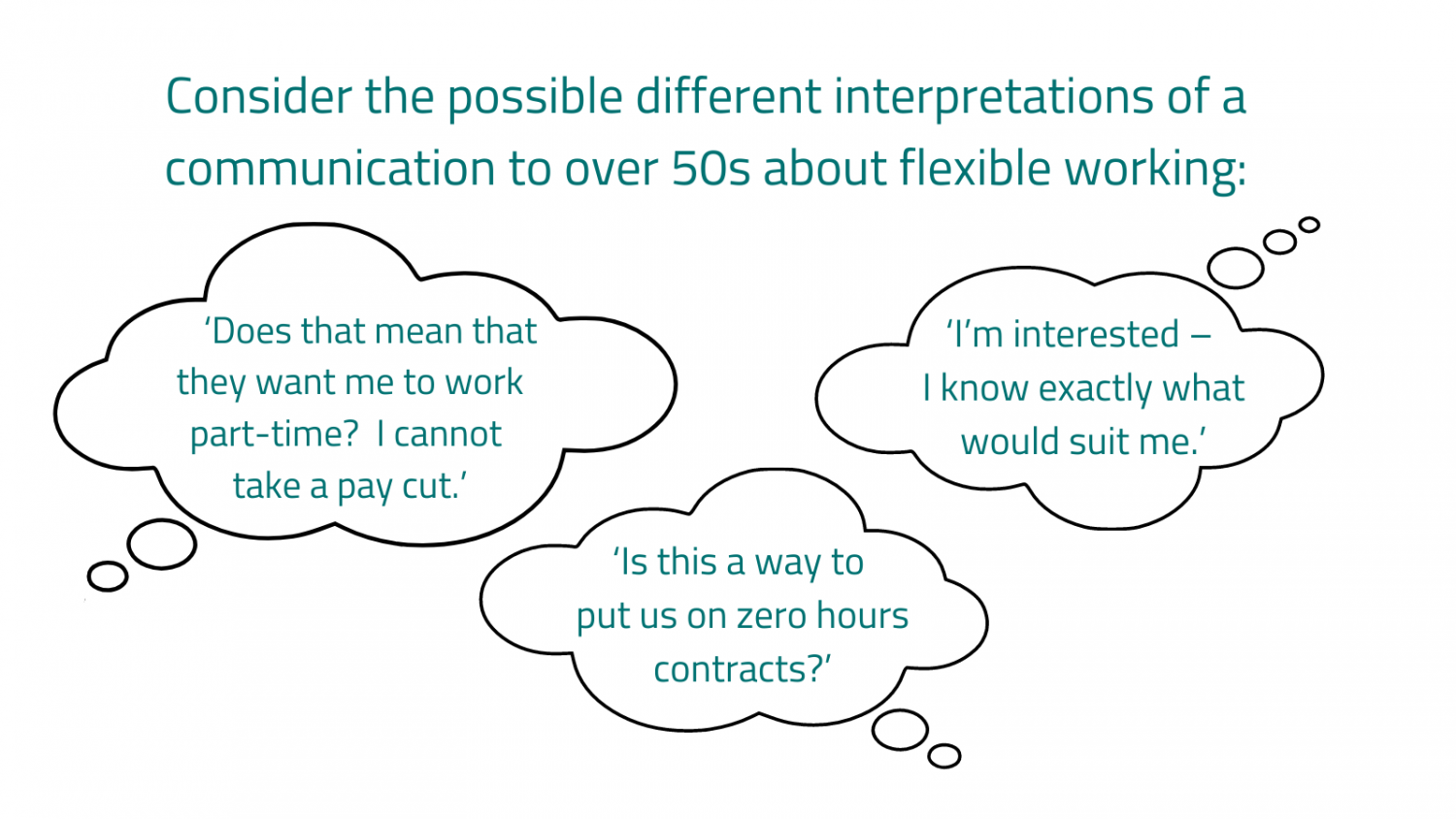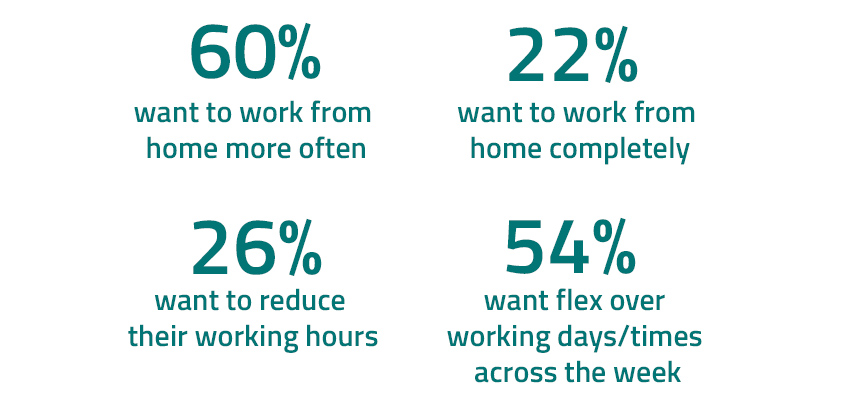

Commissioned by the Centre for Ageing Better, and in partnership with six large employers, Timewise ran an employer intervention programme to explore how flexible working can support a thriving, age inclusive workplace.
The over 50s now stay in work longer, because they want or need to. They increasingly have to balance work with the changes that come with ageing (from physical changes to a desire for more control over how they spend their time). And they make up a third of the UK workforce.
Employers value the experience and skills that over 50s bring to their roles. But the power of flexible working as a retention tool for this demographic has not been given the same level of attention as it has for other groups such as working parents.

Timewise therefore partnered with the Centre for Ageing Better to explore how employers could best support older workers through flexible working. The key findings of the project are reported below, together with details of the methodology.
Although the mechanics of implementing flexible working are the same for all demographics, ‘what happens at the edges’ can be different for older workers:

Appreciating the needs and wants of over 50s will help to engage them in conversations about flexible working, and retain their skills and experience.
Our research and pilot programme explored feelings around whether there was a ‘hierarchy of acceptable reasons for working flexibly’. Both managers and staff felt that:

Flexible working initiatives aimed at older workers need to be carefully managed to ensure there are no perceptions of age discrimination. It’s important for employers to pre-empt how different people may respond, and factor this into communications. The best way to support flexibility for over 50s may be to make it:
Either
Or

This was an 18-month programme in two-phases:
Insights research: The first phase consisted of focus groups and surveys with six large employers: Guy’s and St Thomas’ NHS Foundation Trust, Leeds City Council, Legal & General, McDonalds, Sodexo and Whitbread. We spoke to more than 40 over 50s staff from these organisations, as well as 34 managers with older workers in their teams. We also ran a survey for the over 50s, with 421 respondents, to understand attitudes and perceptions about work-life balance and flexible working, and to gain an insight into their lived experience. This was conducted between November 2018 and February 2019.
Employer pilots: Our research was followed by pilots with Guy’s and St Thomas’ NHS Foundation Trust, and two divisions at Legal & General. The purpose of the pilots was to bring about changes in working patterns for a cohort of over 50s, providing them and their managers with the training and tools to implement and adapt to different flexible working patterns. This part of the programme ran from May 2019 to February 2020, and was completed prior to the covid-19 pandemic.
Many jobseekers have had to put their jobsearch on hold during lockdown. The jobs market has declined significantly, as employers have had to batten down the hatches and adapt to new ways of working, deal with furloughs and redundancies, and in many cases fight for survival.
91% of jobseekers in our survey are understandably nervous about the future jobs market. And, like everyone else, many are dealing with increased pressures at home. So the survey’s first significant heads-up for employers is this: while just over half of those in work have perhaps decided it’s safer to stay put in their current jobs, a sizeable minority (45%) will look to move jobs as soon as they can.

Any employers thinking that retention will not be an issue for a few months, may need to think again. And when the need to recruit arises, they are likely to find that the ground has shifted.
People have had four months of experiencing that jobs can be done from home, and that a 9 to 5 routine isn’t necessary. And fears of the virus are still understandably strong – 71% worry they may catch it on their commute; 76% worry about catching it at their workplace.
So it’s no surprise that when people apply for jobs, they will be looking for flexible working.

This isn’t just a case of people wanting to continue working from home. Our survey found significant levels of interest in all forms of flexible working. The proportion wanting to reduce their hours (26%) is particularly interesting – possibly suggesting that people’s values have changed as a result of covid-19, as they’ve had time and reason to reassess ‘what really matters in life’.

Our recommendation to employers is not to fear the increased demand for flexibility, but to embrace it. The last four months have proved just how productive flexible working can be, and has swept away many of the previous objections and perceived barriers. Separated physically from their colleagues, line managers will have been learning how to judge performance based on outcomes, not on the number of hours spent visibly at a desk. So now is the time to grasp the opportunity, hold on to all the positives of remote working and variable hours, and embed sustainable flexible practices into our workplaces.
Employers’ reputations are at stake here. During lockdown more than ever before, organisations have been watched by their staff. People are observing how well business leaders rise to the challenge of the pandemic and deal fairly with their people, respecting their needs for safety and for the space to take care of the non-working parts of their lives.
The good news is that most employers do seem to have been sympathetic to their staff during lockdown, and supportive of the extra stresses that the virus has brought. The vast majority of the people we surveyed said their employers were either ‘very supportive’ or ‘quite supportive’ across several different measures.

How well organisations continue to meet the needs and expectations of their staff will be vital to employer brand. A consultative, supportive approach will earn the most respect – it will be important to check in with people to ask how they are feeling, post-lockdown, and adopt inclusive working practices going forwards.

Research published July 2020
Methodology: The survey was promoted to the Timewise Jobs database in June 2020. 1,000 jobseekers took part.

Flexible working strategy, for most organisations, still relies on a ‘request-response’ model. That is: an employee makes a request to work part-time or flexibly, and the line manager or HR department responds to that.
It’s a model that Timewise would like to see replaced with a systemic proactive approach. The request-response model is to blame for much of the stigma around flexible working (especially part-time arrangements). This is because it pigeon-holes flexibility as something that’s considered only in special circumstances, predominantly associated with women and childcare.
A proactive approach from managers, by contrast, would make flexibility a gender-neutral matter. It would benefit large numbers of employees (87% want to work flexibly). It would open up flexible career pathways for those already working flexibly. And it would create fairer workplaces, as flexible working is associated with increased diversity and inclusion.
In this research of just under 900 line managers, Timewise with the CMI set out to understand the extent to which proactive approaches are currently being made by line managers.

1 in 5 surveyed managers (21%) had ever proactively offered flexible working at annual review or PDR. A similar proportion (1 in 5, or 19%) had ever offered it when recruiting. And only 1 in 20 (5%) had offered it at the point of promotion.
Timewise considers these to be low proportions, given that the wording of the questions was “Have you ever proactively offered….” To answer positively, a manager may have offered flexible working to only one of their current direct reports, since the introduction of flexible working policies. Additionally, CMI members are more likely than most managers to follow good practice around flexible working; by their nature they take a relatively formal, professional approach to management.
Timewise would like to see significant improvement in proactive discussion of flexible working at these key times. They are moments when career opportunity is under discussion, and when an open approach would be more inclusive of people who need to work flexibly.

Getting and keeping staff is now the number one challenge for the NHS. And the NHS Long Term Plan recognises that poor work-life balance is a key underlying reason.
From our work across many sectors, Timewise knows that work-life balance is a key element of any ‘great place to work’. But how can hard-pressed ward managers, trying to provide 24-hour patient care with limited resources and at the same time satisfy clinical requirements for particular skills on particular shifts, also facilitate work-life balance for nurses?

Timewise set up a pilot to explore one way of addressing this problem. We worked with 240 nurses in seven wards in three hospitals, to test whether a team-based rostering system could improve nurses’ work-life balance. The aim was to increase nurses’ input into their own working patterns.

The education profession is in crisis. Long hours, constantly changing workloads, and better paid opportunities elsewhere, are all factors that are making recruitment and retention an ever increasing challenge.
While flexible working cannot tackle all of these issues, it has a big role to play in improving work-life balance for teachers. It can help make the profession (one dominated by women) more accessible to those with other commitments such as family.
This project explored how to create part-time and flexible pathways in secondary schools. Key points are summarised below.

In the 12 years that Timewise has been focusing on the flexible jobs market, we have heard anecdotal evidence of a key barrier facing part-time employees: a sense of not being fully part of the team.
This research survey set out to quantify the problem. It found that many part-time workers do indeed say they miss out on key meetings, on professional development events and training, and on networking opportunities.
Among the part-time workers who responded to our survey:
If part-time workers are missing out in these ways, they are unlikely to progress as well as their full-time colleagues. Not only is this a waste of their potential, it could also have a negative impact on their organisation’s gender pay gap. By failing to take part-time workers’ schedules into account when planning important meetings and events, employers are making it harder for these employees to deliver their role to the highest standards, and creating operational inefficiencies.
Employers who really want to benefit from the skills and talents of their part-time workers, need to start thinking differently about the best way to support them.
In simple terms, employers need to think differently. They need to challenge the assumption that, just because something has always been done in a certain way – such as entertaining clients after work, or having team meetings on the same day and time each week – that’s the only way to do it.
By thinking creatively and innovatively about how things are done, employers can deliver a workplace culture and working week that is as inclusive of part-time workers as their full-time colleagues – and benefit from the results.
Specific suggestions, made by the part-time workers in our survey include:
Published September 2018

The staffing crisis in the NHS has the organisation close to breaking point. Large numbers of staff are leaving, with many citing work-life balance as their main reason. And recruitment is challenging, with huge numbers of unfilled vacancies. As a result, agency costs for locums and temporary staff are spiralling.
Flexibility could help to tackle these issues, yet there is no clear definition of what flexible working means within the NHS. The organisation currently tends to operate on a request-response model, in which flexibility is seen as a problem to be accommodated rather than a way to meet the non-work needs of their staff. The variety of roles and ways of working in the NHS adds further complexity, with different solutions needed for shift-based working.
In the last year, Timewise has begun working with a range of NHS Trusts to scope how flexible working can enhance their ability to retain staff. We are also conducting an action research project to help NHS Trusts retain nurses within a 24/7 workplace.
Timewise recommends that the NHS implements a three-part Action Plan for Flexibility, to drive sustainable change
1. Define what flexibility means
The NHS needs to develop a clear definition and vision for flexible working
2. Design flexible job roles
The next step is to create flexible job design options for each profession, job role and specialty.
3. Develop a flexible culture
Organisational cultures which drive and promote flexible working at team level will be essential for the changes to be successful.
In this report, we recommend a fresh approach to redesigning NHS jobs and working practices, taking into account the specific clinical and operational constraints in each profession, job role and specialty. This innovative approach to flexible job design will create role-specific flexible options, for staff at all levels, and will help the NHS to:
Flexible working, done well, could help the NHS to deliver a 24/7 environment which works for all their staff, whatever their other responsibilities. The result would be a dramatic increase in the organisation’s ability to attract, nurture, develop and keep its hard working, talented people.
Published July 2018

Our enduring social aim at Timewise is to enable women and men to find the flexibility they need in their careers without reducing their value in the workplace.
Professional services firm Deloitte also shares this aim – providing a working environment where everyone is able to enjoy a successful career alongside a fulfilling life outside work. It is this shared aim that led Timewise and Deloitte to produce our Manifesto for Change.
To prepare our manifesto, a research survey was conducted amongst 1800 professionals working in the UK. The survey was followed up by qualitative research interviews with 12 business leaders.
Key findings from the research are shown below:
The survey identified several perceived barriers to flexible working, including outdated workplace cultures and attitudes that perpetuate the ‘flexibility stigma’. It’s clear that even when business leaders want to accommodate the flexible working needs of their employees, there is a gap between what is said at the top and how that translates to everyday working life.

Because the barriers to embedding flexible working are primarily cultural, success must go beyond a programmatic approach. Both the survey respondents and our interviewees told us that real change only comes when leaders challenge workplace culture and dismantle practices that are no longer fit for purpose.

Based on the survey results, we developed a Manifesto for Change. We want this to be a blueprint for attitudes and actions across UK organisations. We want business leaders to recognise that getting flexible working right will drive success in their business. We want them to share best practice and be brave in trying new approaches.
The following five manifesto actions are what we believe will accelerate workplace change, making it fit for today’s flexible workforce:
Published May 2018
Flexibility in working hours is one of the most important reasons cited for choosing to work in retail1. And yet employees who need flexibility all too often become trapped in shop-floor roles by the lack of opportunities to work part-time or flexibly at store management level.
Following an initial pilot with Pets at Home, Timewise launched our Retail Pioneer Programme in 2017, developed with the BRC and five pioneer partners: B&Q, Cook, Dixons Carphone, Tesco and the John Lewis Partnership.
We set out to understand what was getting in the way of offering flexible working at store management level. Through in-depth research with each of the five retailers, we interrogated and challenged the cultural and operational barriers to flexibility. We then identified key changes needed to break down the barriers, so that employees who need flexibility can progress their careers and employers can make the best use of their talent.
Current take-up of flexible working at the five Retail Pioneers’ stores
How retail staff feel about current practice
Under-utilisation of skills
Talented people who need flexibility are being underdeveloped because of the lack of flexible career progression. This might encourage them to leave the industry, and deter others from joining it.
Diversity issues and the gender pay gap
For some of the five retailers, attracting female talent to their stores was a particular challenge. Other retailers had a diverse gender mix at shop floor level, but this reduced dramatically at supervisor or manager roles. As flexible working is disproportionately attractive to women, there is a real opportunity for flexible career pathways to have a positive impact on the gender pay gap for retailers.
Our research points to the need for a 2 step change process:
1 Redesign existing part-time managerial jobs to make them achievable and attractive, supporting management teams to explore how they can redesign workloads and schedules collaboratively.
2 Open up all roles to flex, promoting and hiring people flexibly into managerial roles.
Based on the insights revealed by our research, we worked closely with each of the five retailers to develop tailored action plans containing our recommended job design options. We have been delighted with the responses from the Pioneers, who are taking a variety of approaches, depending on their particular findings and their business priorities.
1 Retail 2020, What Our People Think, May 2016, BRC
Published May 2018

An ambitious government programme is underway to raise the quality and quantity of apprenticeships, funded in part by the new Apprenticeship Levy. It has catapulted apprenticeships to the top of the agenda for many businesses. The benefits to apprentices, to businesses and to our wider economy and society are considerable.
However, access to high quality apprenticeships is uneven. Gender segregation is entrenched, mirroring the inequalities in the labour market that see women over-represented in low paid, low skilled jobs.
Timewise holds that one root cause of this gender inequality is the lack of part-time or flexible apprenticeships. Just one in ten apprentices are contracted for less than 30 hours per week, leaving the training out of reach for many who are unable to work full-time – particularly women, people with caring responsibilities, disabled people and young people leaving the care system.
This report investigates the feasibility of part-time and flexible models of apprenticeships. It is based on research conducted by Learning and Work Institute and Timewise, supported by the Young Women’s Trust and Trust for London.
The research suggests that part-time and flexible apprenticeships can increase access to skills and allow businesses to reach a broader, more diverse candidate pool. An effective programme would include the following critical success factors:
Timewise are now developing a part-time and flexible apprenticeship model which we intend to pilot later this year. Our goal is to build an evidence base to support a scalable part-time and flexible apprenticeship offer.
Published February 2018